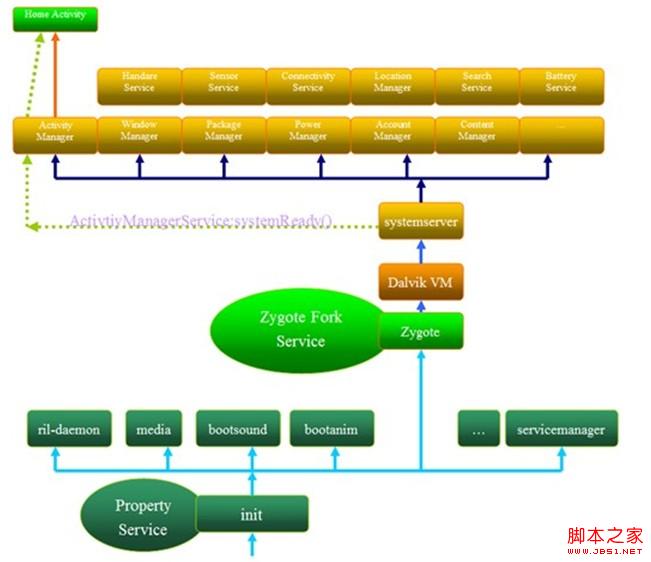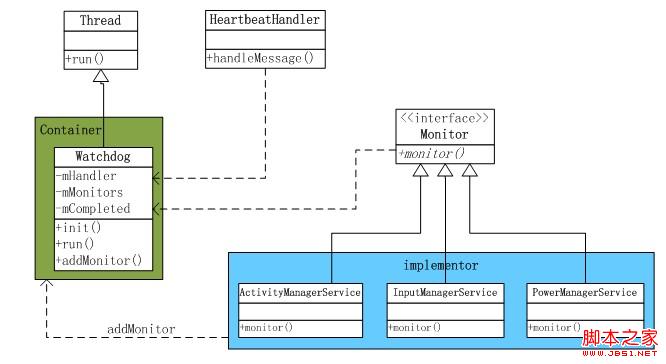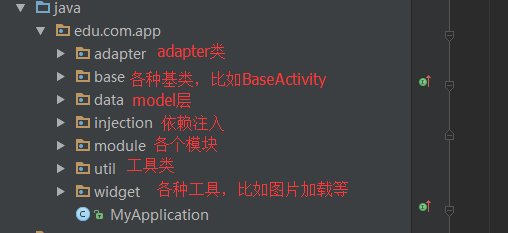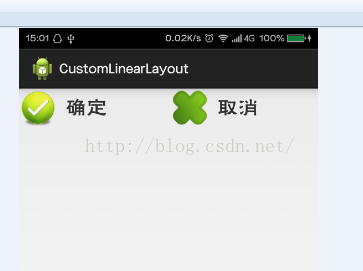系統啟動過程圖:

Framework層所有的Service都是運行在SystemServer進程中;SystemServer進程是由Zygote進程創建。
SystemServer進程啟動分兩個過程init1創建Service和進程狀態對象;init2創建Framework層的Service,將其加入到ServiceManager中,最後啟動launcher;
Android提供了Watchdog類,用來監測Service是否處於正常工作中,是在SystemServer中啟動的。
下面看一下SystemServer中Watchdog這個過程。
SystemServer.java:
復制代碼 代碼如下:
public void run() {
//初始化Watchdog 傳入各個Service作為參數
Watchdog.getInstance().init(context, battery, power, alarm,
ActivityManagerService.self());
//啟動Watchdog
Watchdog.getInstance().start();
}
Watchdog類實現
類繼承結構:

看到Watchdog是一個Thread,運行在SystemServer進程中,單例模式;
HeartbeatHandler處理接受監控的對象(Service),運行在主線程中;
Monitor提供監控接口,接受監控對象實現此接口;
XXXService具體實現的檢測對象。
執行流程:

對外接口
初始化:
復制代碼 代碼如下:
public void init(Context context, BatteryService battery,
PowerManagerService power, AlarmManagerService alarm,
ActivityManagerService activity) {
//存儲Service對象,運行在同一個進程中
mResolver = context.getContentResolver();
mBattery = battery; mPower = power;
mAlarm = alarm; mActivity = activity;
//注冊廣播
context.registerReceiver(new RebootReceiver(),
new IntentFilter(REBOOT_ACTION));
mRebootIntent = PendingIntent.getBroadcast(context,
, new Intent(REBOOT_ACTION), 0);
……
//開機時間
mBootTime = System.currentTimeMillis();
}
注冊監控對象:
復制代碼 代碼如下:
public void addMonitor(Monitor monitor) {
synchronized (this) {
//將監控對象加入到列表中
mMonitors.add(monitor);
}
}
搜索一下此函數的調用,表示被監控;看到在如下Service中實現Watchdog的Monitor接口:
ActivityManagerService
InputManagerService
NetworkManagementService
PowerManagerService
WindowManagerService
都有調用:Watchdog.getInstance().addMonitor(this);
Watchdog線程執行函數:
復制代碼 代碼如下:
public void run() {
boolean waitedHalf = false;
while (true) {
//監測完成標志
mCompleted = false;
//發送監測消息
mHandler.sendEmptyMessage(MONITOR);
synchronized (this) {
long timeout = TIME_TO_WAIT;
long start = SystemClock.uptimeMillis();
while (timeout > 0 && !mForceKillSystem) {
//休眠等待檢查結果
wait(timeout); // notifyAll() is called when mForceKillSystem is set
timeout = TIME_TO_WAIT - (SystemClock.uptimeMillis() - start);
}
if (mCompleted && !mForceKillSystem) {
//檢查結果OK
waitedHalf = false;
continue;
}
//在進行檢查一次
if (!waitedHalf) {
ActivityManagerService.dumpStackTraces(true, pids, null, null,
NATIVE_STACKS_OF_INTEREST);
waitedHalf = true;
continue;
}
}
//表明監控對象有問題
// If we got here, that means that the system is most likely hung.
// First collect stack traces from all threads of the system process.
// Then kill this process so that the system will restart.
//保存stack信息
……
// Only kill the process if the debugger is not attached.
if(!Debug.isDebuggerConnected()) {
if(SystemProperties.getInt("sys.watchdog.disabled", 0) == 0) {
//kill當前進程SystemServer
Process.killProcess(Process.myPid());
System.exit(10);
}
}
waitedHalf = false;
}
}
在此run函數中循環發送消息,判斷標志是否正常,決定檢測對象是否正常工作。
若監測對象不正常工作,則收集重要的stack信息保存下來,然後重啟SystemServer。
監測消息的處理:
是在HeartbeatHandler中進行,看看消息處理函數。
復制代碼 代碼如下:
public void handleMessage(Message msg) {
switch (msg.what) {
case MONITOR: {
// See if we should force a reboot.
//監測對象是否正常工作中……
final int size = mMonitors.size();
for (int i = 0 ; i < size ; i++) {
//調用監測對象的monitor接口
mCurrentMonitor = mMonitors.get(i);
mCurrentMonitor.monitor();
}
//走到這裡表明監測對象正常
synchronized (Watchdog.this) {
mCompleted = true;
mCurrentMonitor = null;
}
} break;
}
}
判斷監測對象是否正常工作,通過調用監測對象實現的接口monitor,看看這個接口該如何執行的。
PowerManagerService中:
public void monitor() {
//判斷Service是否發生死鎖,如果發生死鎖,程序將在此一直等待//主要是線程間同步問題 造成死鎖
synchronized (mLocks) { }
}
以上便是Watchdog監測Service是否正常工作的流程;我們也可以使用Watchdog來監測別的資源如內存等使用情況。
這個Watchdog給我們提供了一種思路,一種框架,對程序正常運行或者資源的正常使用情況等的一種監測機制。



 Android ListView適配器(Adapter)優化方法詳解
Android ListView適配器(Adapter)優化方法詳解
 映客直播怎麼領取微信紅包
映客直播怎麼領取微信紅包
 Android開發架構規范
Android開發架構規范
 android自定義LinearLayout和View
android自定義LinearLayout和View